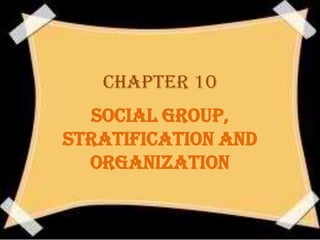
Chapter 10
- 1. CHAPTER 10 SOCIAL GROUP, STRATIFICATION AND ORGANIZATION
- 2. . Chemist and Physicists have arranged all substances that appear on earth into a small number of classes, called “ELEMENTS”. Biologists, similarly, have arranged plants and animals and insects into a small number of classes, called “SPECIES”.
- 3. “No Man Normally lives alone” -Aristotle
- 4. GROUPS
- 5. GROUPS • 1. Statistical Group- are “formed”, not by the members themselves but by sociologists and staticians • Examples: Those people who were born on a Tuesday, those Filipinos who have owned public utility vehicles, and those number of dropouts from school.
- 6. . 2. Societal Groups This category of group differs from statistical groups in one very important characteristics – “consciousness of kind”. It was introduced into sociology by Franklin Henry Giddings. Example of Societal Groups: Females, the aged, the Muslims, plumbers, golfers and the blind. Including all ethnic groups, all regional groups, all occupational groups
- 7. . 3. Social Groups The word “social” implies social contact and communication, social interaction and social intercourse. Social Groups are those in which people actually associate with one another and have social relations with one another. Examples: Friendship, acquaintance groups, classroom groups, cliques, crowds, audiences, congregation, kinship groups, passengers on the same ship, neighborhood groups and play groups.
- 8. . 4. Associational Groups- This is considered as the most important kind of group in modern complex societies. Examples: Our college of University is an association, the red cross, a committee, football team. The army and the Navy are associations and so on.
- 9. . In the case of each of these FORMAL PROPERTIES, we find a set of dual categories which are: a. Primary Groups- The concept of Primary Group was introduced into American sociology by Charles Horton Cooley. Cooley meant the intimate, personal, “Face to Face” groups in which we find our companions and comrades, the members of our family, and our daily associates. b. Secondary Group- The concept of E.T. Hiller in secondary groups are “categoric” and “extrinsic”.
- 10. . • b) In – Groups and Out Groups – This category has no specific size and may indeed be highly variable. In – Groups- It may be small as family or as a large as the world. Out – Groups – is simply everybody who is not in the family or not in the world Note: The in – group, in short, is only OUR GROUP. While in the out – group is EVERYBODY ELSE.
- 11. . C. Large Groups and Small Groups. Some of the other formal properties of groups are more familiar and require a less extended discussion. Examples: A large army is superior to a small one, a large country is more powerful than a small one, and a large corporation has more control over a market than a small one.
- 12. . D. Majority Groups and Minority Groups Majorities and Minorities, ofcourse, are always components of other groups and the terms have no meaning in themselves. Examples: The majorities may be very small (two out of a group of three friends) and minorities very large (those who supported the candidate in a presidential election) although not in the same context. But even in the same group a majority may be large or small.
- 13. . E. Long- lived Groups and Short – Lived Groups The duration of a group, its span of existence is also one of the more important of its properties. Examples: Parliament of Iceland, the Masonic Lodge, and the church Rome.
- 14. . F. Voluntary Groups and Involuntary Groups Involuntary Group- are our age group, sex group, ethnic group, based as they are upon biological properties. Voluntary Group- No one is required by law to read a certain newspaper or to listen to a given radio program.
- 15. . G. Open Groups and Closed Groups Some groups are relatively open and some are relatively closed.
- 16. ETHNICITY
- 17. ETHNICITY • refers to social categorization based on differences in national origin, language and religion
- 18. . Social Structure: Stratification David B. Brinkerhoff (1988) – defined social stratifications as an institutionalized pattern of inequality in which social categories are ranked on the basis of their access to scarce resources. Everett K. Wilson (1971) – defined stratification which means a hierarchical ordering of social positions along the scale of group’s values.
- 19. . Several types of social classes 1.Upper – upper 2. Lower –upper 3. Upper middle 4. Lower middle 5. Upper –lower 6. Lower – lower
- 20. Criteria and types of social classes
- 21. . 1. Wealth, property, Income- The criterion of financial resources 2. Family or kinship- criterion of class states or class position 3. Location of Residence- Criterion that occurs in all groups. 4. Occupation- The criterion of work and highrank or status in their occupational associations. 5. Education- the criterion of university status, knowledge performance task and general education. 6. Religion- the criterion of class status but candid investigation where there is a variety of sets discloses that it may not be altogether ignored
- 22. . Class and Race Racial discrimination between white and Negro it is the criterion of status and opportunity Class and Demographic Variables Demographic variables- longevity, fertility, morality- correlate with class. Class and Lifestyles People differ by the level of education achieved and used this as an index of social status- the person spend his money